

Compact Muon Solenoid
LHC, CERN
| CMS-PAS-SUS-16-024 | ||
| Search for electroweak SUSY production in multilepton final states in 12.9 fb$^{-1}$ of pp collision data at $ \sqrt{s} = $ 13 TeV | ||
| CMS Collaboration | ||
| August 2016 | ||
| Abstract: Searches for the direct electroweak production of supersymmetric charginos and neutralinos are presented in signatures with two light leptons of the same charge and with three or more leptons including up to two hadronically decaying taus. Results are based on a sample of proton-proton collision data collected at a center-of-mass energy $ \sqrt{s} = $ 13 TeV with the CMS detector in 2016, corresponding to an integrated luminosity of 12.9 fb$^{-1}$. The observed event rates are in agreement with expectations from the standard model. These results probe charginos and neutralinos with masses up to 400-1000 GeV depending on the assumed model parameters. | ||
| Links: CDS record (PDF) ; inSPIRE record ; CADI line (restricted) ; | ||
| Figures & Tables | Summary | Additional Figures & Tables | References | CMS Publications |
|---|
| Additional information on efficiencies needed for reinterpretation of these results are available here. |
| Figures | |

png pdf |
Figure 1-a:
Chargino-neutralino pair production with decays mediated by (a) sleptons and (b) sneutrinos and leading to leptonic final states. Chargino-neutralino pair production decaying directly to an LSP via a W and (c) a Z boson or (d) a Higgs boson. (e) Gaugino pair production decaying to a gravitino LSP via a Z boson. |

png pdf |
Figure 1-b:
Chargino-neutralino pair production with decays mediated by (a) sleptons and (b) sneutrinos and leading to leptonic final states. Chargino-neutralino pair production decaying directly to an LSP via a W and (c) a Z boson or (d) a Higgs boson. (e) Gaugino pair production decaying to a gravitino LSP via a Z boson. |

png pdf |
Figure 1-c:
Chargino-neutralino pair production with decays mediated by (a) sleptons and (b) sneutrinos and leading to leptonic final states. Chargino-neutralino pair production decaying directly to an LSP via a W and (c) a Z boson or (d) a Higgs boson. (e) Gaugino pair production decaying to a gravitino LSP via a Z boson. |

png pdf |
Figure 1-d:
Chargino-neutralino pair production with decays mediated by (a) sleptons and (b) sneutrinos and leading to leptonic final states. Chargino-neutralino pair production decaying directly to an LSP via a W and (c) a Z boson or (d) a Higgs boson. (e) Gaugino pair production decaying to a gravitino LSP via a Z boson. |
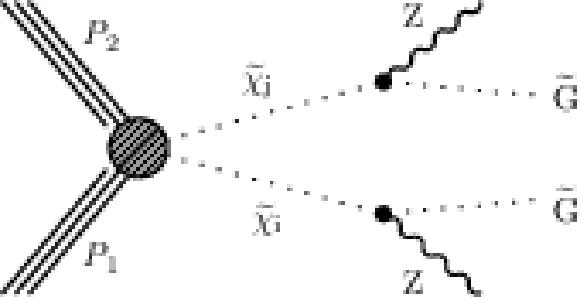
png pdf |
Figure 1-e:
Chargino-neutralino pair production with decays mediated by (a) sleptons and (b) sneutrinos and leading to leptonic final states. Chargino-neutralino pair production decaying directly to an LSP via a W and (c) a Z boson or (d) a Higgs boson. (e) Gaugino pair production decaying to a gravitino LSP via a Z boson. |

png pdf |
Figure 2-a:
Comparison of the expected and observed yields in trilepton signal regions: three light leptons (a) with and (b) without an OSSF pair. The lower panel shows the ratio between the observed and expected yields in all signal regions, with the dark blue band indicating the statistical background uncertainty, and the light blue band corresponding to the total background uncertainty propagated to the ratio. |
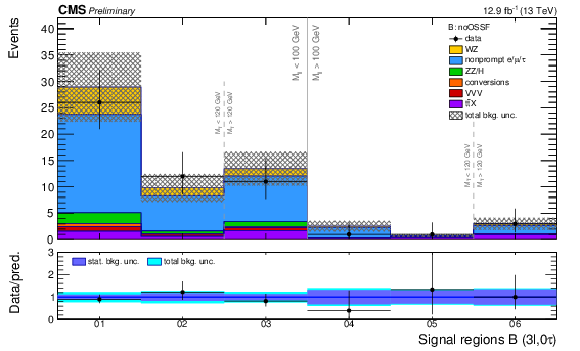
png pdf |
Figure 2-b:
Comparison of the expected and observed yields in trilepton signal regions: three light leptons (a) with and (b) without an OSSF pair. The lower panel shows the ratio between the observed and expected yields in all signal regions, with the dark blue band indicating the statistical background uncertainty, and the light blue band corresponding to the total background uncertainty propagated to the ratio. |
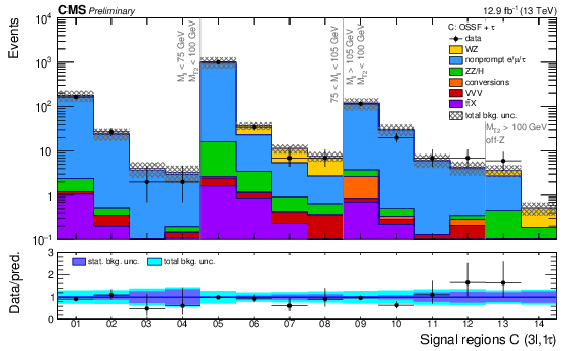
png pdf |
Figure 3-a:
Comparison of the expected and observed yields in trilepton signal regions: $ {\tau _\text {h}} $ and two light leptons of the opposite sign and same flavor (a) or different flavor (b). The lower panel shows the ratio between the observed and expected yields in all signal regions, with the dark blue band indicating the statistical background uncertainty, and the light blue band corresponding to the total background uncertainty propagated to the ratio. |
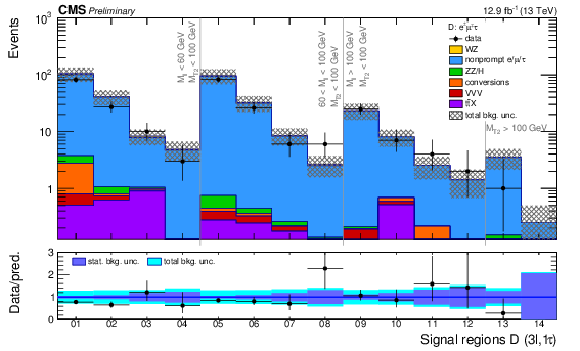
png pdf |
Figure 3-b:
Comparison of the expected and observed yields in trilepton signal regions: $ {\tau _\text {h}} $ and two light leptons of the opposite sign and same flavor (a) or different flavor (b). The lower panel shows the ratio between the observed and expected yields in all signal regions, with the dark blue band indicating the statistical background uncertainty, and the light blue band corresponding to the total background uncertainty propagated to the ratio. |

png pdf |
Figure 4-a:
Comparison of the expected and observed yields in trilepton signal regions: two light leptons of the same sign and a $ {\tau _\text {h}} $ (a), and a light lepton and two $ {\tau _\text {h}} $ (b). The lower panel shows the ratio between the observed and expected yields in all signal regions, with the dark blue band indicating the statistical background uncertainty, and the light blue band corresponding to the total background uncertainty propagated to the ratio. |

png pdf |
Figure 4-b:
Comparison of the expected and observed yields in trilepton signal regions: two light leptons of the same sign and a $ {\tau _\text {h}} $ (a), and a light lepton and two $ {\tau _\text {h}} $ (b). The lower panel shows the ratio between the observed and expected yields in all signal regions, with the dark blue band indicating the statistical background uncertainty, and the light blue band corresponding to the total background uncertainty propagated to the ratio. |
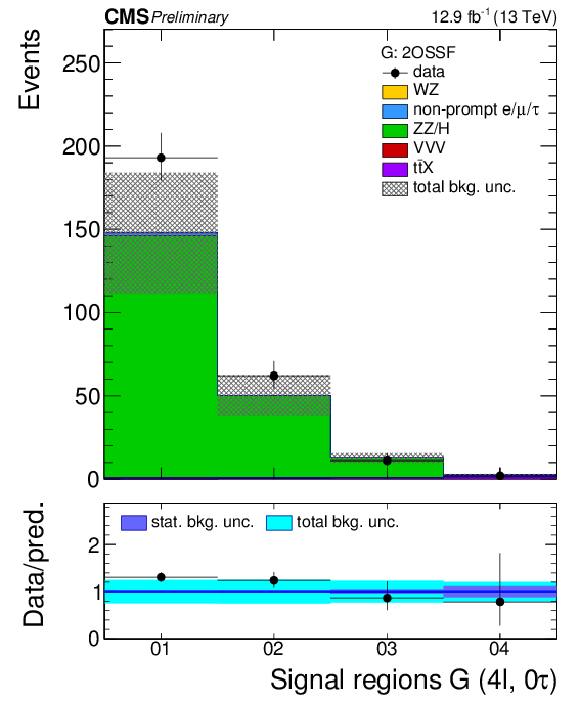
png pdf |
Figure 5-a:
Comparison of the expected and observed yields in four lepton signal regions. The (a) plot shows the events with no taus and at least 2 OSSF pairs, the (b) plot shows events with no taus and less than 2 OSSF pairs while the (c) plot contains events with at least one $ {\tau _\text {h}} $. The lower panel shows the ratio between the observed and expected yields in all signal regions, with the dark blue band indicating the statistical background uncertainty, and the light blue band corresponding to the total background uncertainty propagated to the ratio. |

png pdf |
Figure 5-b:
Comparison of the expected and observed yields in four lepton signal regions. The (a) plot shows the events with no taus and at least 2 OSSF pairs, the (b) plot shows events with no taus and less than 2 OSSF pairs while the (c) plot contains events with at least one $ {\tau _\text {h}} $. The lower panel shows the ratio between the observed and expected yields in all signal regions, with the dark blue band indicating the statistical background uncertainty, and the light blue band corresponding to the total background uncertainty propagated to the ratio. |
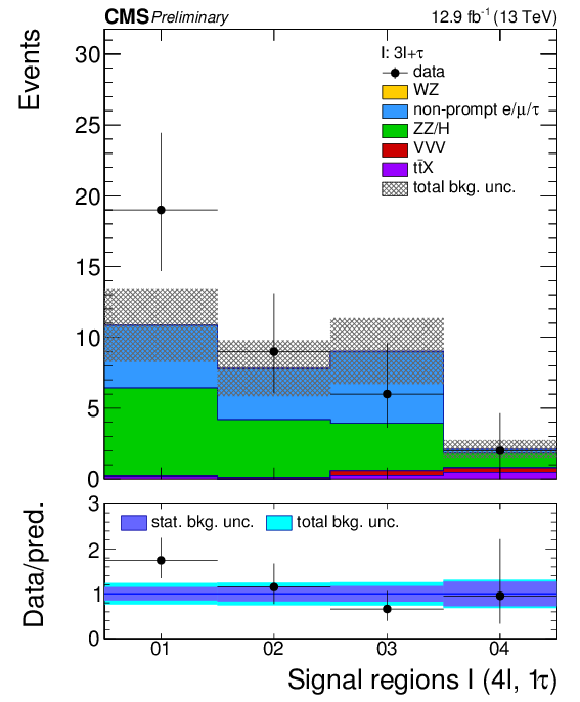
png pdf |
Figure 5-c:
Comparison of the expected and observed yields in four lepton signal regions. The (a) plot shows the events with no taus and at least 2 OSSF pairs, the (b) plot shows events with no taus and less than 2 OSSF pairs while the (c) plot contains events with at least one $ {\tau _\text {h}} $. The lower panel shows the ratio between the observed and expected yields in all signal regions, with the dark blue band indicating the statistical background uncertainty, and the light blue band corresponding to the total background uncertainty propagated to the ratio. |

png pdf |
Figure 6:
Expected yields and observed counts for the search regions defined in the same-sign dilepton category. The blue line represents the yield in the flavor-democratic scenario of $ {\tilde{\chi}^0_2} {\tilde{\chi}^\pm } _1$ production with $m_{ {\tilde{\chi}^0_2} } = m_{ {\tilde{\chi}^\pm } _1} = $ 400 GeV, $m_{ {\tilde{\chi}^0_1} } = $ 300 GeV, and $ x_{\tilde{\ell}} = $ 0.05, scaled up by a factor of 5. The lower panel shows the ratio between the observed and expected yields in all signal regions, with the dark blue band indicating the statistical background uncertainty, and the light blue band corresponding to the total background uncertainty propagated to the ratio. |

png pdf root |
Figure 7:
Interpretation of the results of the three-lepton search in the flavor-democratic signal model with slepton mass parameter $ x_{\tilde{\ell}} = $ 0.5. The shading in the $m_{ {\tilde{\chi}^{0}} _1}$ versus $m_{ {\tilde{\chi}^{0}} _2}$ ($=m_{ {\tilde{\chi}^{\pm }} _1}$) plane indicates the 95% CL upper limit on the chargino-neutralino production cross section times branching fraction. The contours bound the mass regions excluded at 95% CL assuming the NLO+NLL cross sections for a branching fraction of 50%, as appropriate for the visible decay products in this scenario. The observed, ${\pm }1\sigma _{\text {theory}}$ observed, median expected, and $\pm$1$ \sigma _{\text {experiment}}$ expected bounds are shown. |
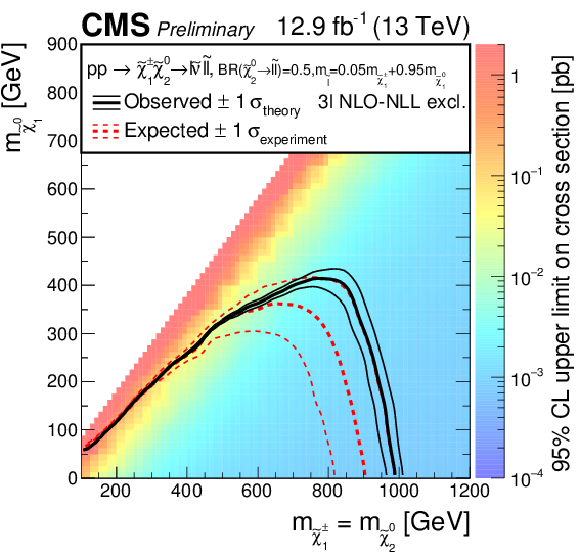
png pdf root |
Figure 8-a:
Interpretation of the results of the three-lepton search in the flavor-democratic signal model with slepton mass parameter $ x_{\tilde{\ell}} = $ 0.05 obtained with (a) trilepton search, (b) same-sign dilepton search and (c) the combination of the two analyses. The shading in the $m_{ {\tilde{\chi}^{0}} _1}$ versus $m_{ {\tilde{\chi}^{0}} _2}$ ($=m_{ {\tilde{\chi}^{\pm }} _1}$) plane indicates the 95% CL upper limit on the chargino-neutralino production cross section times branching fraction. The contours bound the mass regions excluded at 95% CL assuming the NLO+NLL cross sections for a branching fraction of 50%, as appropriate for the visible decay products in this scenario. The observed, ${\pm }$1$\sigma _{\text {theory}}$ observed, median expected, and $\pm$1$ \sigma _{\text {experiment}}$ expected bounds are shown. |

png pdf root |
Figure 8-b:
Interpretation of the results of the three-lepton search in the flavor-democratic signal model with slepton mass parameter $ x_{\tilde{\ell}} = $ 0.05 obtained with (a) trilepton search, (b) same-sign dilepton search and (c) the combination of the two analyses. The shading in the $m_{ {\tilde{\chi}^{0}} _1}$ versus $m_{ {\tilde{\chi}^{0}} _2}$ ($=m_{ {\tilde{\chi}^{\pm }} _1}$) plane indicates the 95% CL upper limit on the chargino-neutralino production cross section times branching fraction. The contours bound the mass regions excluded at 95% CL assuming the NLO+NLL cross sections for a branching fraction of 50%, as appropriate for the visible decay products in this scenario. The observed, ${\pm }$1$\sigma _{\text {theory}}$ observed, median expected, and $\pm$1$ \sigma _{\text {experiment}}$ expected bounds are shown. |
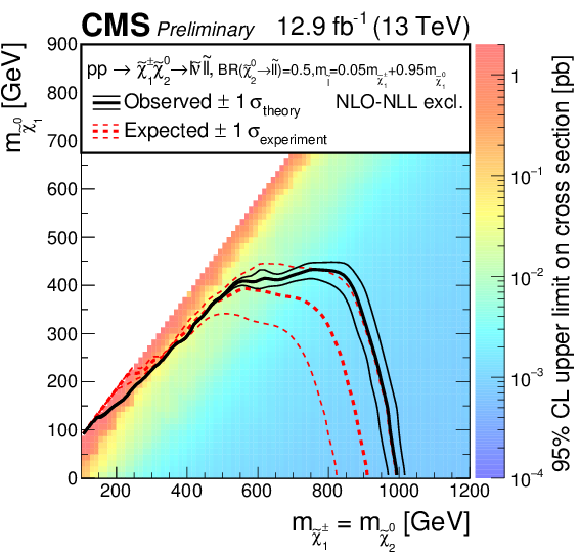
png pdf root |
Figure 8-c:
Interpretation of the results of the three-lepton search in the flavor-democratic signal model with slepton mass parameter $ x_{\tilde{\ell}} = $ 0.05 obtained with (a) trilepton search, (b) same-sign dilepton search and (c) the combination of the two analyses. The shading in the $m_{ {\tilde{\chi}^{0}} _1}$ versus $m_{ {\tilde{\chi}^{0}} _2}$ ($=m_{ {\tilde{\chi}^{\pm }} _1}$) plane indicates the 95% CL upper limit on the chargino-neutralino production cross section times branching fraction. The contours bound the mass regions excluded at 95% CL assuming the NLO+NLL cross sections for a branching fraction of 50%, as appropriate for the visible decay products in this scenario. The observed, ${\pm }$1$\sigma _{\text {theory}}$ observed, median expected, and $\pm$1$ \sigma _{\text {experiment}}$ expected bounds are shown. |

png pdf root |
Figure 9:
Interpretation of the results of the three-lepton search in the tau-dominated signal model with slepton mass parameter $ x_{\tilde{\ell}} =$ 0.5. The shading in the $m_{ {\tilde{\chi}^{0}} _1}$ versus $m_{ {\tilde{\chi}^{0}} _2}$ ($=m_{ {\tilde{\chi}^{\pm }} _1}$) plane indicates the 95% CL upper limit on the chargino-neutralino production cross section times branching fraction. The contours bound the mass regions excluded at 95% CL assuming the NLO+NLL cross sections for a branching fraction of 100%. The observed, ${\pm }$1$\sigma _{\text {theory}}$ observed, median expected, and $\pm$1$ \sigma _{\text {experiment}}$ expected bounds are shown. |
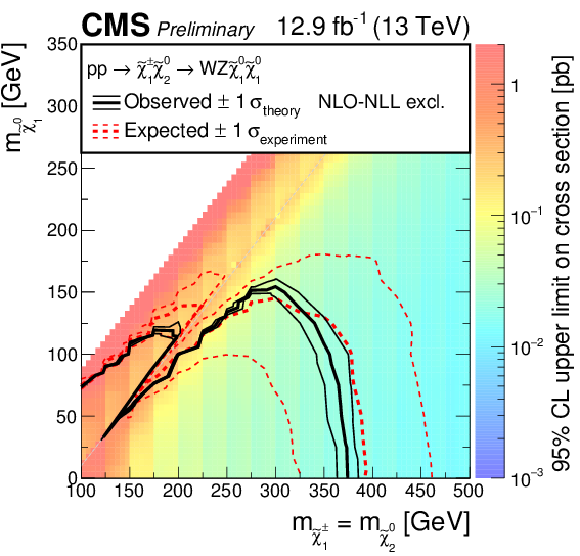
png pdf root |
Figure 10-a:
Interpretation of the results of the three-lepton search in the scenarios without intermediate light sleptons present and yielding (a) WZ+$ {E_{\mathrm {T}}^{\text {miss}}} $ or (b) WH+$ {E_{\mathrm {T}}^{\text {miss}}} $ in the final state. The shading in the $m_{ {\tilde{\chi}^{0}} _1}$ versus $m_{ {\tilde{\chi}^{0}} _2}$ ($=m_{ {\tilde{\chi}^{\pm }} _1}$) plane indicates the 95% CL upper limit on the chargino-neutralino production cross section times branching fraction. The contours bound the mass regions excluded at 95% CL assuming the NLO+NLL cross sections for a branching fraction of 100%. The observed, ${\pm }$1$\sigma _{\text {theory}}$ observed, median expected, and $\pm$1$\sigma _{\text {experiment}}$ expected bounds are shown. |
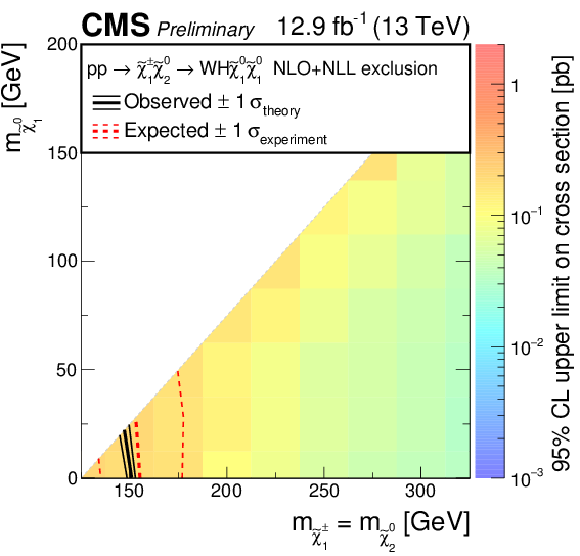
png pdf root |
Figure 10-b:
Interpretation of the results of the three-lepton search in the scenarios without intermediate light sleptons present and yielding (a) WZ+$ {E_{\mathrm {T}}^{\text {miss}}} $ or (b) WH+$ {E_{\mathrm {T}}^{\text {miss}}} $ in the final state. The shading in the $m_{ {\tilde{\chi}^{0}} _1}$ versus $m_{ {\tilde{\chi}^{0}} _2}$ ($=m_{ {\tilde{\chi}^{\pm }} _1}$) plane indicates the 95% CL upper limit on the chargino-neutralino production cross section times branching fraction. The contours bound the mass regions excluded at 95% CL assuming the NLO+NLL cross sections for a branching fraction of 100%. The observed, ${\pm }$1$\sigma _{\text {theory}}$ observed, median expected, and $\pm$1$\sigma _{\text {experiment}}$ expected bounds are shown. |
| Tables | |

png pdf |
Table 1:
Search regions for events with three $ {\mathrm {e}}$ or $\mu $ that form at least one OSSF pair. |

png pdf |
Table 2:
Search regions for events with three $ {\mathrm {e}}$ or $\mu $ that do not form an OSSF pair. |

png pdf |
Table 3:
Search region definition for events with 2 $ {\mathrm {e}}$ or $\mu $ forming an OSSF pair and one $ {\tau _\text {h}} $. Regions where there is a Z candidate are not split in $ {M_{\text {T}2}} $ categories. |

png pdf |
Table 4:
Search region definition for events with one $ {\mathrm {e}}$ and one $\mu $ of opposite charge and one $ {\tau _\text {h}} $. |

png pdf |
Table 5:
Search region definition for events with 2 $ {\mathrm {e}}$ or $\mu $ of the same charge and one $ {\tau _\text {h}} $. |

png pdf |
Table 6:
Search region definition for events with one electron or muon and 2 $ {\tau _\text {h}} $. |

png pdf |
Table 7:
Search region definition for events with four or more leptons. |

png pdf |
Table 8:
Search regions for events with two same-sign light flavor leptons. |

png pdf |
Table 9:
Summary of systematic uncertainties in the event yields in the search regions. The upper group lists uncertainties related to experimental factors for all processes whose yield is estimated from simulation; the middle group lists uncertainties in these yields related to the event simulation process itself. The lower group lists uncertainties for background processes whose yield is estimated from data. |
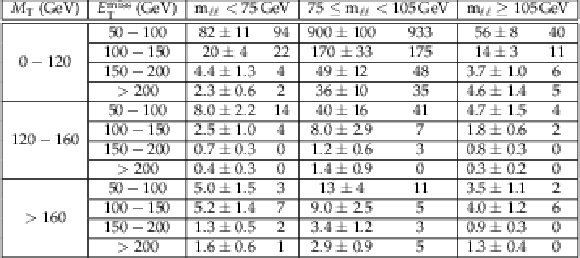
png pdf |
Table 10:
Expected and observed yields in events with three $ {\mathrm {e}}$ or $\mu $ that form one OSSF pair. Uncertainty denotes total uncertainty on the result. |

png pdf |
Table 11:
Expected and observed yields in events with three $ {\mathrm {e}}$ or $\mu $ that do not form an OSSF pair. Uncertainty denotes total uncertainty on the result. |

png pdf |
Table 12:
Expected and observed yields in events with two $ {\mathrm {e}}$ or $\mu $ forming and OSSF pair and one $ {\tau _\text {h}} $. Uncertainty denotes total uncertainty on the result. |

png pdf |
Table 13:
Expected and observed yields in events with an opposite-sign $ {\mathrm {e}}\mu $ pair and one $ {\tau _\text {h}} $. Uncertainty denotes total uncertainty on the result. |

png pdf |
Table 14:
Expected and observed yields in events with one same-sign $ {\mathrm {e}}$ or $\mu $ and one $ {\tau _\text {h}} $. Uncertainty denotes total uncertainty on the result. |

png pdf |
Table 15:
Expected and observed yields in events with one $ {\mathrm {e}}$ or $\mu $ and two $ {\tau _\text {h}} $. Uncertainty denotes total uncertainty on the result. |

png pdf |
Table 16:
Expected and observed yields in the $4\ell $ category of the analysis. The uncertainty denotes the total uncertainty on the result. |

png pdf |
Table 17:
Search regions for events with two same-sign light flavor leptons. The uncertainties include both systematic and statistical components. |
| Summary |
| The results of a search for new physics in same-sign dilepton, trilepton and four-lepton events containing up to two hadronically decaying ${\tau_\text{h}} $ using the CMS detector at the LHC and based on a data sample of pp collisions at $\sqrt{s} = $ 13 TeV, corresponding to an integrated luminosity of 12.9 fb$^{-1}$, are presented. The data are split into categories formed according to the number, sign and flavor of the leptons, and are further subdivided in various kinematic regions to be sensitive to a broad range of electroweakly produced new particles. No significant deviation from the standard model expectations is observed. The results are used to set limits on the various simplified models with a chargino-neutralino pair production which is the electroweak SUSY process with the largest cross section. The resulting signal topologies depend on the masses of the sleptons. Models with light left sleptons enhance the branching fraction to final states with three leptons. Depending on the left/right mixing and flavor of these sleptons, our results probe charginos and neutralinos with masses up to 1 TeV for the flavor-democratic scenario which extends the reach of the previous result [11] by about 300 GeV. In these models, searches in the same-sign dilepton final state enhance the sensitivity in the experimentally challenging region with small mass difference between the produced gauginos and an LSP, and allow to probe the regions inaccessible by the trilepton signature. In case chargino and neutralino decay to three taus and LSP in the final state, the masses of charginos up to 450 GeV are probed, extending the sensitivity of the previous search by 150 GeV. The most challenging considered scenarios are the direct decay of produced gauginos to LSP via W and Z or Higgs bosons. For the final states with W and Z bosons, the chargino masses is probed up to 400 GeV. This improves the previous reach by 130 GeV. In case of the neutralino decay via a Higgs boson, only masses up to 150 GeV can be probed, which does not add a new sensitivity over results achieved in the previous searches. |
| Additional Figures | |

png pdf |
Additional Figure 1:
$ {M_\text {T}} $ distribution in the WZ trilepton control region: 35 GeV $ < {E_{\mathrm {T}}^{\text {miss}}} < $ 100 GeV, $ {N_\text {jets}} \le $ 1. |
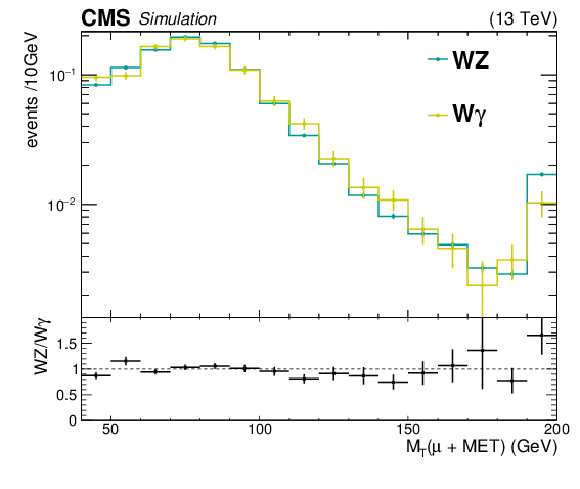
png pdf |
Additional Figure 2:
$ {M_\text {T}} $ shape comparison in MC simulations of the WZ and $W\gamma $ processes. |

png pdf |
Additional Figure 3:
$ {E_{\mathrm {T}}^{\text {miss}}} $ shape comparison in MC simulations of the WZ and W$\gamma $ processes. |
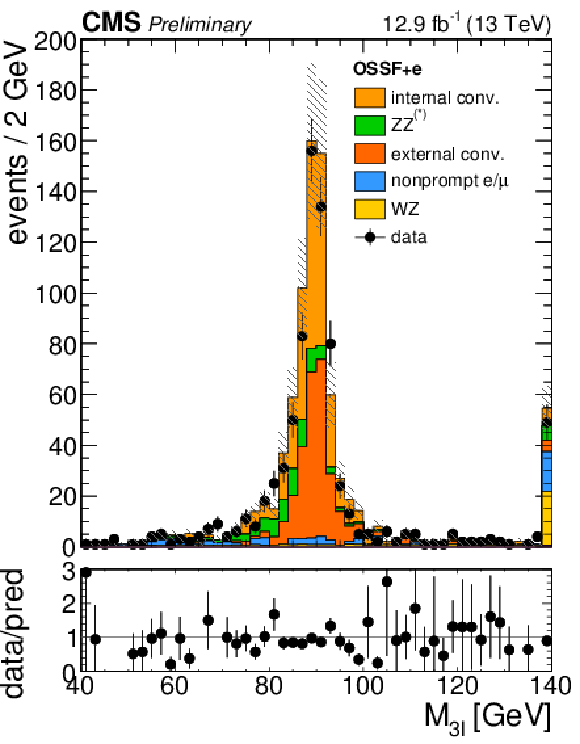
png pdf |
Additional Figure 4:
Invariant mass of three light leptons containing an OSSF pair and an electron in the conversions control region: $ {E_{\mathrm {T}}^{\text {miss}}} < 50 GeV $, $ {M_{\ell \ell }} < 75 GeV $. |
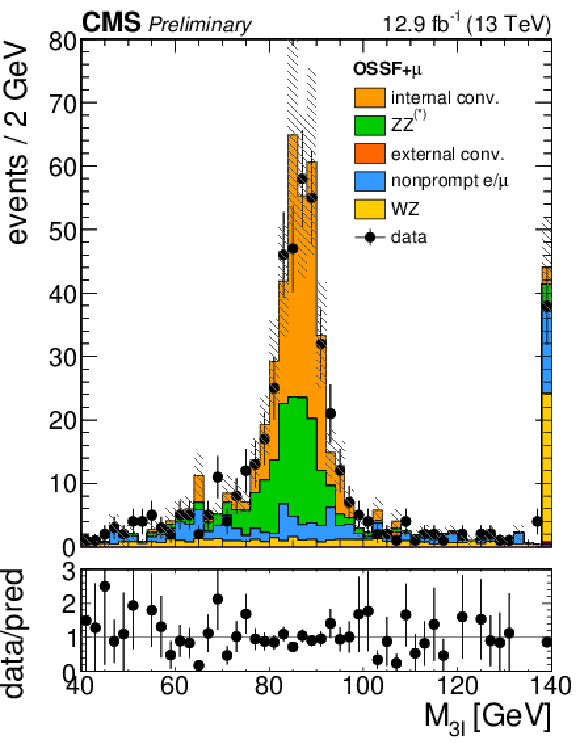
png pdf |
Additional Figure 5:
Invariant mass of three light leptons containing an OSSF pair and a muon in the conversions control region: $ {E_{\mathrm {T}}^{\text {miss}}} < $ 50 GeV, $ {M_{\ell \ell }} < $ 75 GeV. |
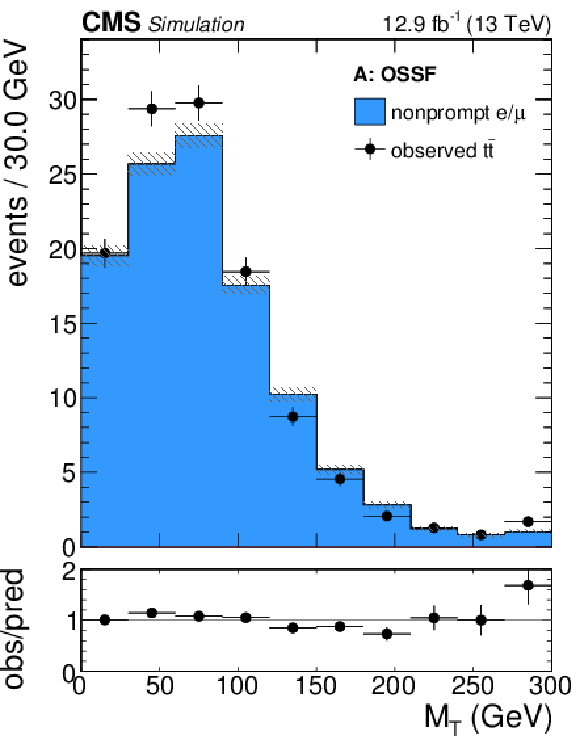
png pdf |
Additional Figure 6:
Nonprompt lepton method performance in the MC ${\mathrm{ t } {}\mathrm{ \bar{t} } } $ simulation: three light leptons selection. |

png pdf |
Additional Figure 7:
Nonprompt lepton method performance in the MC ${\mathrm{ t } {}\mathrm{ \bar{t} } } $ simulation: an OSSF dilepton and a hadronic tau selection. |

png pdf |
Additional Figure 8:
Nonprompt lepton method performance in the MC ${\mathrm{ t } {}\mathrm{ \bar{t} } } $ simulation: an OSOF dilepton and a hadronic tau selection. |
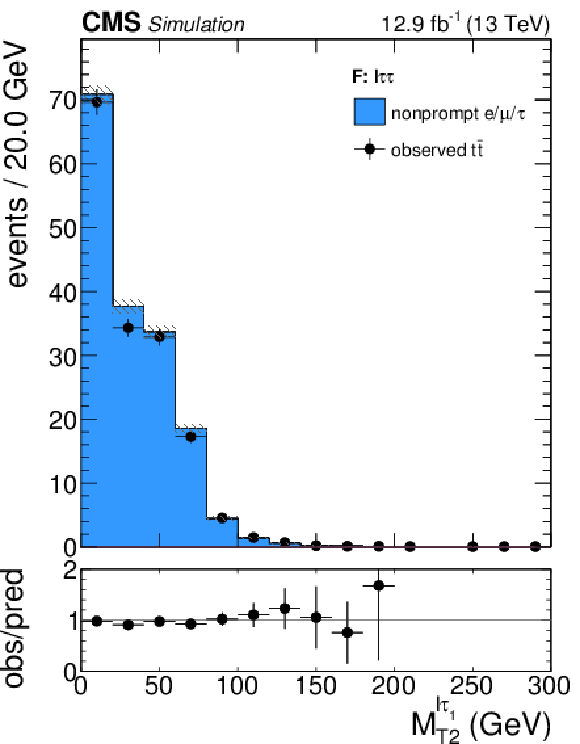
png pdf |
Additional Figure 9:
Nonprompt lepton method performance in the MC ${\mathrm{ t } {}\mathrm{ \bar{t} } } $ simulation: a light lepton and two hadronic taus selection. |

png pdf |
Additional Figure 10:
Data vs prediction comparison for the minimum transverse mass built with each lepton and the ${E_{\mathrm {T}}^{\text {miss}}}$ in the baseline region of the same-sign dilepton search. |

png pdf |
Additional Figure 11:
Data vs prediction comparison for the dilepton-system ${p_{\mathrm {T}}}$ in the baseline region of the same-sign dilepton search. |

png pdf |
Additional Figure 12:
Data vs prediction comparison for the number of jets with ${p_{\mathrm {T}}} > $ 40 GeV in the baseline region of the same-sign dilepton search. |

png pdf |
Additional Figure 13:
The flavor composition of the three leptons in baseline region A. |
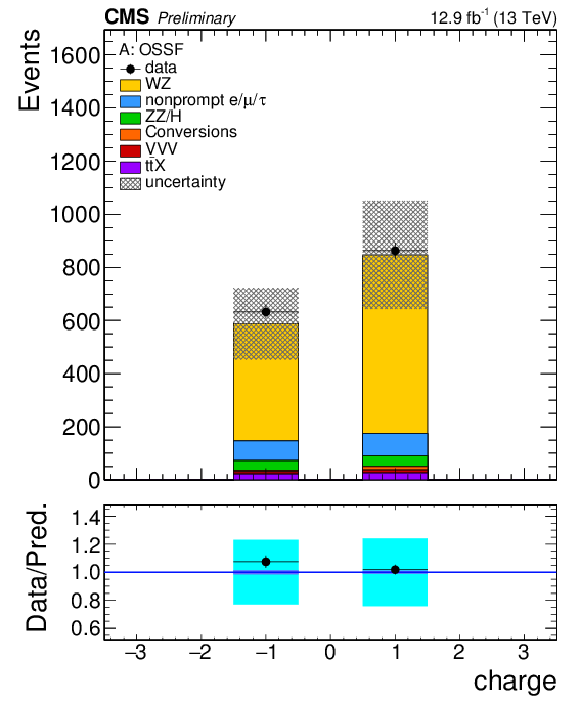
png pdf |
Additional Figure 14:
The total charge of the three leptons in baseline region A. |
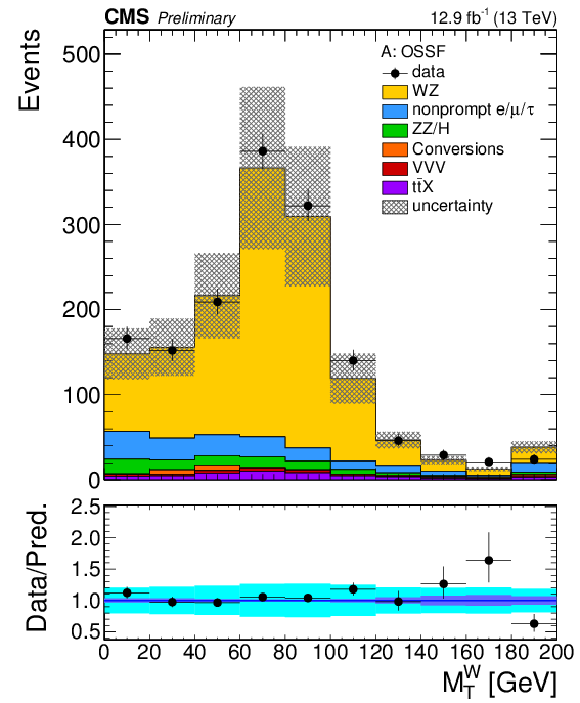
png pdf |
Additional Figure 15:
The transverse mass of the third lepton in baseline region A. |
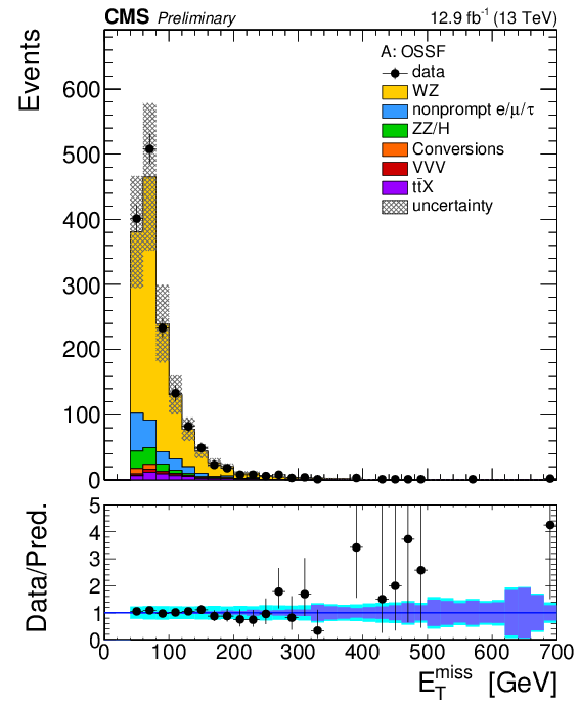
png pdf |
Additional Figure 16:
The $ {E_{\mathrm {T}}^{\text {miss}}} $ in baseline region A. |

png pdf |
Additional Figure 17:
The flavor composition of the three leptons in baseline region B. |
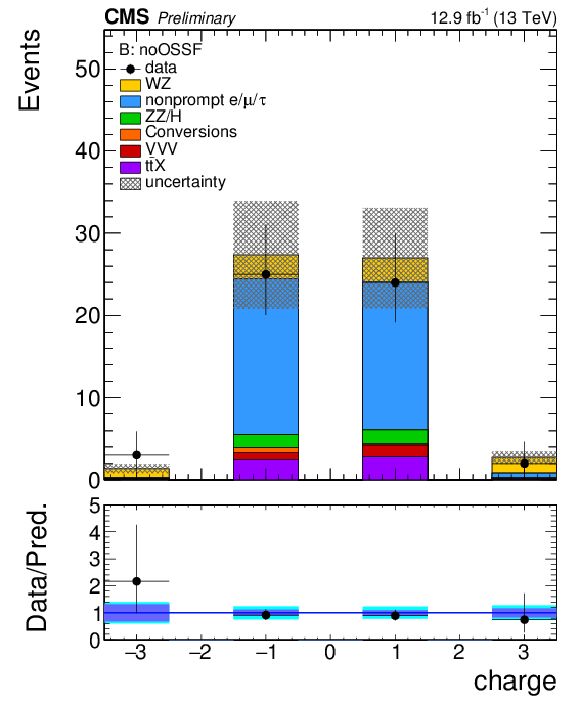
png pdf |
Additional Figure 18:
The total charge of the three leptons in baseline region B. |
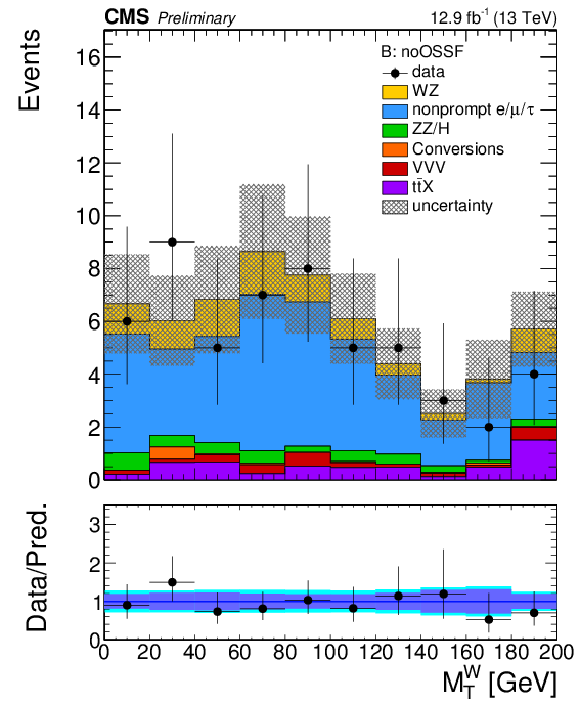
png pdf |
Additional Figure 19:
The transverse mass of the third lepton in baseline region B. |
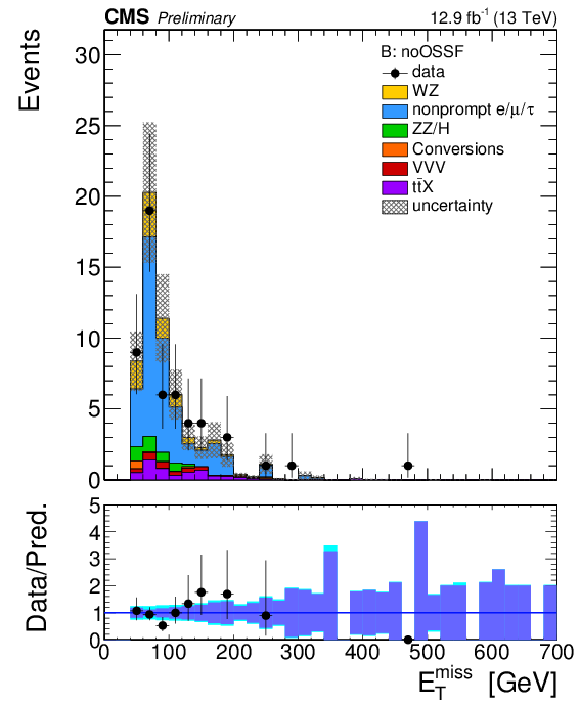
png pdf |
Additional Figure 20:
The $ {E_{\mathrm {T}}^{\text {miss}}} $ in baseline region B. |

png pdf |
Additional Figure 21:
The total charge of the three leptons in baseline region C. |
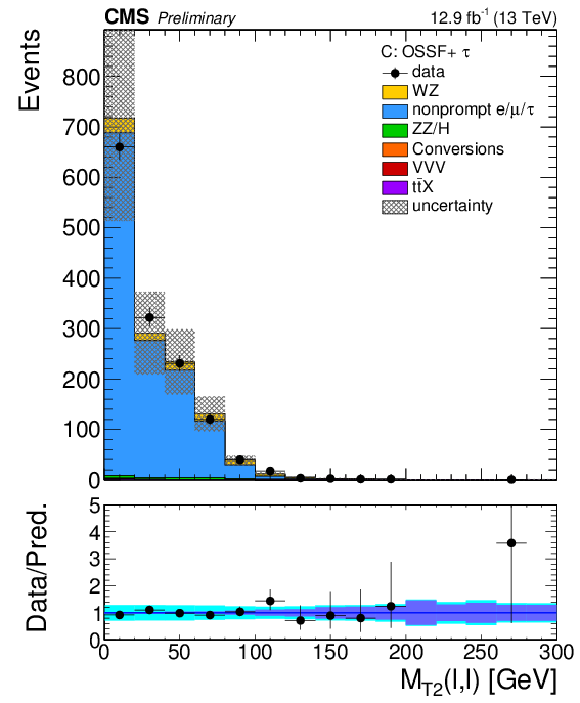
png pdf |
Additional Figure 22:
The stransverse mass of two light leptons in baseline region C. |

png pdf |
Additional Figure 23:
The $ {E_{\mathrm {T}}^{\text {miss}}} $ in baseline region C. |

png pdf |
Additional Figure 24:
The total charge of the three leptons in baseline region D. |

png pdf |
Additional Figure 25:
The stransverse mass of two light leptons in baseline region D. |
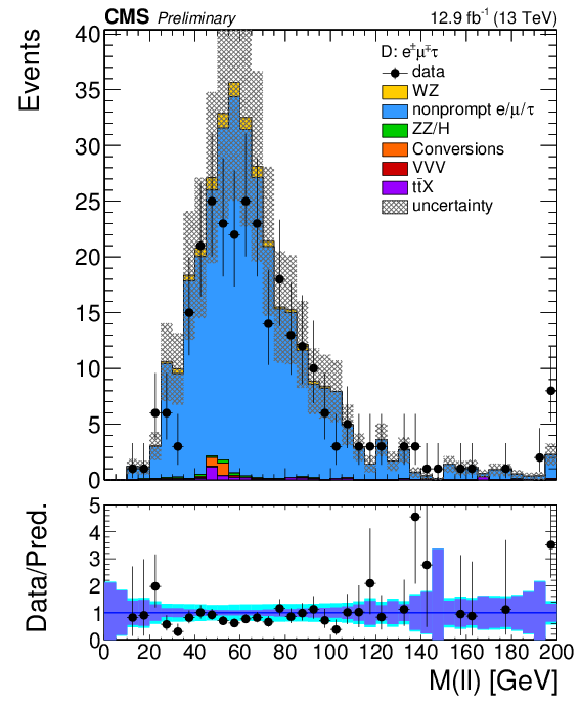
png pdf |
Additional Figure 26:
the invariant mass of the two leptons forming the OS pair in baseline region D. |
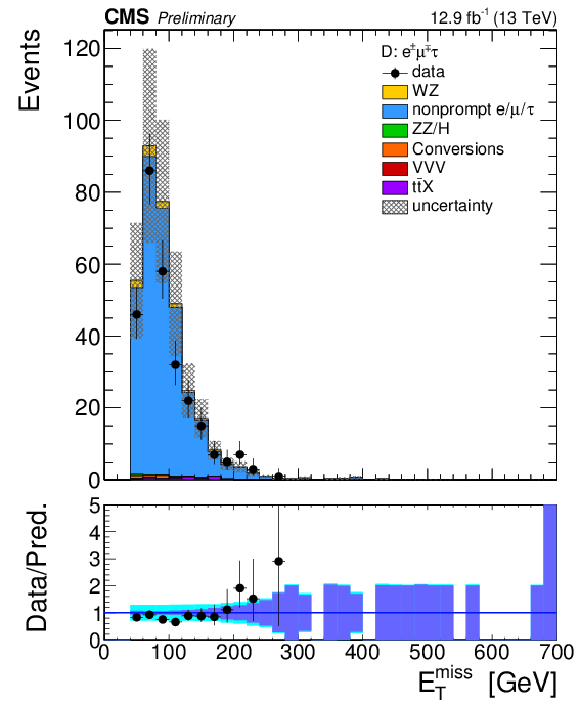
png pdf |
Additional Figure 27:
The $ {E_{\mathrm {T}}^{\text {miss}}} $ in baseline region D. |

png pdf |
Additional Figure 28:
The total charge of the three leptons in baseline region E. |

png pdf |
Additional Figure 29:
The total charge of the three leptons in baseline region F. |

png pdf |
Additional Figure 30:
The stransverse mass of the light lepton and a leading tau in baseline region F. |
| Additional Tables | |
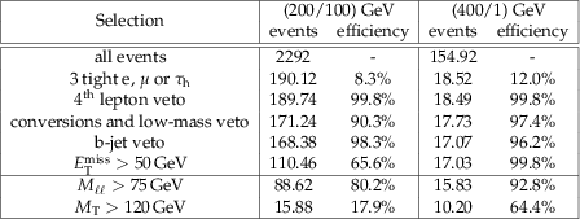
png pdf |
Additional Table 1:
Cut-flow for the same-sign dilepton channel for a given mass point: flavor-democratic chargino-neutralino production, with $m_{ {\tilde{\chi}^0_2} } = $ 400 GeV, $m_{ {\tilde{\chi}^0_1} }=$ 100 GeV, and $m_{ {\tilde{\ell }} } = 0.05\times m_{ {\tilde{\chi}^0_2} } + 0.95\times m_{ {\tilde{\chi}^0_1} } = $ 115 GeV. |

png pdf |
Additional Table 2:
Cut-flow for the trilepton channel for a compressed ($m_{ {\tilde{\chi}^0_2} } $ 200 GeV, $m_{ {\tilde{\chi}^0_1} }= $ 175 GeV) and an uncompressed mass point ($m_{ {\tilde{\chi}^0_2} } =$ 450 GeV, $m_{ {\tilde{\chi}^0_1} }=$ 100 GeV) for the $ {\tilde{\chi}^0_2} \tilde{\chi}^{\pm} _1\to \tau \tau \tau {\tilde{\chi}^0_1} {\tilde{\chi}^0_1} $ model which involves the production of three taus in the decay chain. |
| References | ||||
| 1 | P. Ramond | Dual theory for free fermions | PRD 3 (1971) 2415 | |
| 2 | \relax Yu. A. Golfand and E. P. Likhtman | Extension of the algebra of Poincare group generators and violation of P invariance | JEPTL 13 (1971) 323.[Pisma Zh. Eksp. Teor. Fiz. 13 (1971) 452] | |
| 3 | A. Neveu and J. H. Schwarz | Factorizable dual model of pions | Nucl. Phys. B 31 (1971) 86 | |
| 4 | D. V. Volkov and V. P. Akulov | Possible universal neutrino interaction | JEPTL 16 (1972) 438.[Pisma Zh. Eksp. Teor. Fiz. 16 (1972) 621] | |
| 5 | J. Wess and B. Zumino | A lagrangian model invariant under supergauge transformations | PLB 49 (1974) 52 | |
| 6 | J. Wess and B. Zumino | Supergauge transformations in four-dimensions | Nucl. Phys. B 70 (1974) 39 | |
| 7 | P. Fayet | Supergauge invariant extension of the Higgs mechanism and a model for the electron and its neutrino | Nucl. Phys. B 90 (1975) 104 | |
| 8 | H. P. Nilles | Supersymmetry, supergravity and particle physics | PR 110 (1984) 1 | |
| 9 | S. P. Martin | A supersymmetry primer | in Perspectives on Supersymmetry II, G. L. Kane, ed., 2010 | hep-ph/9709356 |
| 10 | CMS Collaboration | Phenomenological MSSM interpretation of CMS searches in pp collisions at $ \sqrt{s} $ = 7 and 8 TeV | CMS-SUS-15-010 1606.03577 |
|
| 11 | CMS Collaboration | Searches for electroweak production of charginos, neutralinos, and sleptons decaying to leptons and W, Z, and Higgs bosons in pp collisions at 8 TeV | EPJC 74 (2014), no. 9 | CMS-SUS-13-006 1405.7570 |
| 12 | CMS Collaboration | Searches for electroweak neutralino and chargino production in channels with Higgs, Z, and W bosons in pp collisions at 8 TeV | PRD 90 (2014), no. 9, 092007 | CMS-SUS-14-002 1409.3168 |
| 13 | CMS Collaboration | Search for supersymmetry in the multijet and missing transverse momentum final state in pp collisions at 13 TeV | PLB 758 (2016) 152--180 | CMS-SUS-15-002 1602.06581 |
| 14 | CMS Collaboration | Search for new physics with the MT2 variable in all-jets final states produced in pp collisions at $ \sqrt{s} $ = 13 TeV | CMS-SUS-15-003 1603.04053 |
|
| 15 | CMS Collaboration | Search for supersymmetry in pp collisions at $ \sqrt{s} $ = 13 TeV in the single-lepton final state using the sum of masses of large-radius jets | CMS-SUS-15-007 1605.04608 |
|
| 16 | CMS Collaboration | Search for new physics in same-sign dilepton events in proton-proton collisions at $ \sqrt{s} $ = 13 TeV | CMS-SUS-15-008 1605.03171 |
|
| 17 | CMS Collaboration | The CMS experiment at the CERN LHC | JINST 3 (2008) S08004 | CMS-00-001 |
| 18 | CMS Collaboration | Particle-Flow Event Reconstruction in CMS and Performance for Jets, Taus, and MET | CDS | |
| 19 | CMS Collaboration | Commissioning of the Particle--Flow reconstruction in Minimum--Bias and Jet Events from pp Collisions at 7~TeV | CDS | |
| 20 | M. Cacciari, G. P. Salam, and G. Soyez | FastJet User Manual | EPJC 72 (2012) 1896 | 1111.6097 |
| 21 | M. Cacciari and G. P. Salam | Dispelling the $ N^{3} $ myth for the $ k_\text{T} $ jet-finder | PLB 641 (2006) 57--61 | hep-ph/0512210 |
| 22 | CMS Collaboration | Determination of jet energy calibration and transverse momentum resolution in CMS | JINST 6 (2011) P11002 | CMS-JME-10-011 1107.4277 |
| 23 | CMS Collaboration | Identification of b quark jets at the CMS Experiment in the LHC Run 2 | CMS-PAS-BTV-15-001 | CMS-PAS-BTV-15-001 |
| 24 | CMS Collaboration | Performance of the CMS missing transverse momentum reconstruction in pp data at $ \sqrt{s} = $ 8 TeV | JINST 10 (2015) P02006 | CMS-JME-13-003 1411.0511 |
| 25 | CMS Collaboration | Performance of CMS muon reconstruction in pp collision events at $ \sqrt{s} = $ 7 TeV | JINST 7 (2012) P10002 | CMS-MUO-10-004 1206.4071 |
| 26 | CMS Collaboration | Performance of electron reconstruction and selection with the CMS detector in proton-proton collisions at $ \sqrt{s} = $ 8 TeV | JINST 10 (2015) P06005 | CMS-EGM-13-001 1502.02701 |
| 27 | K. Rehermann and B. Tweedie | Efficient identification of boosted semileptonic top quarks at the LHC | JHEP 03 (2011) 059 | 1007.2221 |
| 28 | CMS Collaboration | Search for $ \mathrm{ t \bar{t} } $H production in multilepton final states at $ \sqrt{s} $ = 13 TeV | CMS-PAS-HIG-15-008 | CMS-PAS-HIG-15-008 |
| 29 | B. P. Roe et al. | Boosted decision trees, an alternative to artificial neural networks | NIMA 543 (2005), no. 2-3, 577--584 | physics/0408124 |
| 30 | CMS Collaboration | Reconstruction and identification of $ \tau $ lepton decays to hadrons and $ \nu_\tau $ at CMS | JINST 11 (2016), no. 01, P01019 | CMS-TAU-14-001 1510.07488 |
| 31 | CMS Collaboration | Performance of reconstruction and identification of tau leptons in their decays to hadrons and tau neutrino in LHC Run-2 | CMS-PAS-TAU-16-002 | CMS-PAS-TAU-16-002 |
| 32 | J. Alwall et al. | The automated computation of tree-level and next-to-leading order differential cross sections, and their matching to parton shower simulations | JHEP 07 (2014) 079 | 1405.0301 |
| 33 | T. Melia, P. Nason, R. Rontsch, and G. Zanderighi | $ \mathrm{ W }^+ \mathrm{ W }^- $, $ \mathrm{ W } \mathrm{ Z } $ and $ \mathrm{ Z } \mathrm{ Z } $ production in the POWHEG BOX | JHEP 11 (2011) 078 | 1107.5051 |
| 34 | P. Nason and G. Zanderighi | $ \mathrm{ W }^+ \mathrm{ W }^- $, $ \mathrm{ W } \mathrm{ Z } $ and $ \mathrm{ Z } \mathrm{ Z } $ production in the POWHEG-BOX-V2 | EPJC 74 (2014) 2702 | 1311.1365 |
| 35 | NNPDF Collaboration | Parton distributions for the LHC Run II | JHEP 04 (2015) 040 | 1410.8849 |
| 36 | T. Sj\"ostrand, S. Mrenna, and P. Z. Skands | A brief introduction to PYTHIA 8.1 | CPC 178 (2008) 852 | 0710.3820 |
| 37 | P. Skands, S. Carrazza, and J. Rojo | Tuning PYTHIA 8.1: the Monash 2013 tune | EPJC 74 (2014) 3024 | 1404.5630 |
| 38 | CMS Collaboration | Event generator tunes obtained from underlying event and multiparton scattering measurements | EPJC 76 (2016) 155 | CMS-GEN-14-001 1512.00815 |
| 39 | GEANT4 Collaboration | GEANT4---a simulation toolkit | NIMA 506 (2003) 250 | |
| 40 | S. Abdullin et al. | The fast simulation of the CMS detector at LHC | J. Phys. Conf. Ser. 331 (2011) 032049 | |
| 41 | D. Alves et al. | Simplified models for LHC new physics searches | JPG 39 (2012) 105005 | 1105.2838 |
| 42 | CMS Collaboration | Interpretation of searches for supersymmetry with simplified models | PRD 88 (2013) 052017 | CMS-SUS-11-016 1301.2175 |
| 43 | C. G. Lester and D. J. Summers | Measuring masses of semiinvisibly decaying particles pair produced at hadron colliders | PLB 463 (1999) 99 | hep-ph/9906349 |
| 44 | A. Barr, C. Lester, and P. Stephens | m(T2): The truth behind the glamour | JPG 29 (2003) 2343 | hep-ph/0304226 |
| 45 | CMS Collaboration | CMS luminosity measurement for the 2015 data taking period | CMS-PAS-LUM-15-001 | CMS-PAS-LUM-15-001 |
| 46 | T. Junk | Confidence level computation for combining searches with small statistics | NIMA 434 (1999) 435 | hep-ex/9902006 |
| 47 | A. L. Read | Presentation of search results: The $ CL_s $ technique | JPG 28 (2002) 2693 | |
| 48 | ATLAS and CMS Collaborations | Procedure for the LHC Higgs boson search combination in summer 2011 | CMS-NOTE-2011-005 | |
| 49 | B. Fuks, M. Klasen, D. R. Lamprea, and M. Rothering | Gaugino production in proton-proton collisions at a center-of-mass energy of 8 TeV | JHEP 10 (2012) 081 | 1207.2159 |
| 50 | B. Fuks, M. Klasen, D. R. Lamprea, and M. Rothering | Precision predictions for electroweak superpartner production at hadron colliders with Resummino | EPJC 73 (2013) 2480 | 1304.0790 |
| 51 | B. Fuks, M. Klasen, D. R. Lamprea, and M. Rothering | Revisiting slepton pair production at the Large Hadron Collider | JHEP 01 (2014) 168 | 1310.2621 |

|
Compact Muon Solenoid LHC, CERN |

|

|

|

|

|

|